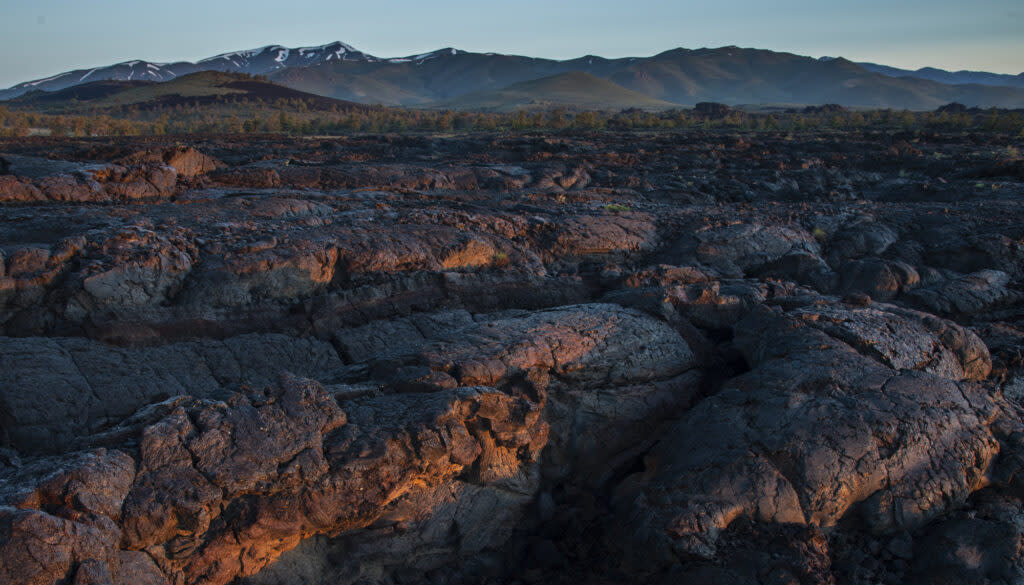Craters of the Moon is Idaho’s ‘weird and scenic landscape.’ Let’s celebrate its centennial.

- Oops!Something went wrong.Please try again later.
Pahoehoe lava at Craters of the Moon National Monument and Preserve. Three special kinds of pahoehoe may be observed in the Craters of the Moon Lava Field: Slabby pahoehoe is made up of jumbled plates or slabs of broken pahoehoe crust; shelly pahoehoe, which forms from gas-charged lava, contains small open tubes, blisters, and thin crusts; and spiny pahoehoe, which is very thick and pasty, contains elongated gas bubbles on the surface that form spines. (Courtesy of Craters of the Moon National Monument and Preserve)
“Right here in Idaho, a miniature replica of the moon country, a riot of color and fantastic shapes so unearthly as to make one believe himself on another planet.” This is how Boise explorer Robert W. Limbert described the otherworldly landscape that has been Craters of the Moon National Monument and Preserve in southern Idaho for almost a century.
Limbert’s writings and photographs of this spectacular volcanic landscape, including an article published in National Geographic years before radio and decades before television became widely available, captured the imagination of the public — and the president of the United States.
In his proclamation establishing Craters of the Moon National Monument on May 2, 1924, President Calvin Coolidge described this land as “an area which contains a remarkable fissure eruption together with its associated volcanic cones, craters, rifts, lava flows, caves, natural bridges, and other phenomena characteristic of volcanic action which are of unusual scientific value and general interest.” A “weird and scenic landscape, peculiar to itself,” according to Coolidge.
As we celebrate Craters of the Moon’s Centennial this year, it is important to reflect not only on the significance of this special place, but also how it fits into the bigger conservation picture. Craters of the Moon National Monument, created just eight years after the 1916 founding of the National Park Service, was the agency’s first park to be located entirely within the state of Idaho. The monument was initially set aside to protect its volcanic features, but there is so much more to this unusual landscape, however.
Its rich cultural history begins as the ancestral lands of the Shoshone and Bannock peoples.
There are over 43,000 acres of tranquil designated wilderness.
NASA scientists and astronauts have been using the park as a robust research laboratory since 1969.
The expansive dark night sky makes it one of the best places for stargazing in the country.
Craters of the Moon also provides refuge for a surprising diversity of plant and wildlife species and serves as an “anchor” for ecosystem connectivity between the north Snake River Plain and the mountains of central Idaho.
We owe gratitude to those who had the foresight to create this collection of places for future generations to experience. And looking forward, undoubtedly, the importance of Craters of the Moon will continue to grow as its resources help expand our understanding about the impacts of climate change, prepare for deeper space exploration, and advance research questions on topics we have not yet contemplated.
The monument’s centennial provides the perfect moment for both new and returning visitors to take the time to explore Craters of the Moon. We invite visitors to experience the many opportunities we are offering this year to learn about its history, diversity and complexity, which we call “phases of the moon.” These include viewing special exhibits at the Robert Limbert Visitor Center and participating in full moon hikes, star parties, activities led by artists in residence, and other special events. Check out the schedule of events at go.nps.gov/CRMO100
Our centennial celebration will also include a monthly guest opinion from now through September in this publication. Each will be focused on a different “phase of the moon.”
The post Craters of the Moon is Idaho’s ‘weird and scenic landscape.’ Let’s celebrate its centennial. appeared first on Idaho Capital Sun.

